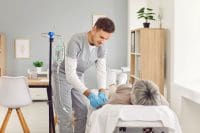My stethoscope lay curled in the bottom of my bathroom drawer with other nursing tools—penlights, watches with second hands, and old badges and lanyards. I hadn’t touched my stethoscope in a while because I’d spent the last several years in quality management and patient safety.
As I picked it up and draped the stethoscope across my neck, memories flooded my mind. As I examined it, I thought I needed to get it repaired and replace the plastic diaphragm on the bell and maybe reduce the stiffness of the tubing. I called the manufacturer and told them that I wanted to send the stethoscope in for repairs. The company representative asked about the make and model, which I provided. Her reply was, “We don’t service that model anymore; it’s too old.”
The stethoscope was stiff like my knees and lower back, which was to be expected. I’d had it for most of my nursing career. My very first stethoscope was a graduation present from my dad but it was stolen on my first job. I made sure my next stethoscope never left my side.
My old stethoscope was like an old friend. I recalled my surgical intensive care unit days and how I kept my stethoscope close to me. I used it on every patient and every shift.
This Christmas, my husband Frank bought me a beautiful new stethoscope. As I draped it across my neck, I felt how soft and pliable it is. The bell is shiny and has a rainbow pattern. I should have been delighted but I was surprised to realize that I was grieving the loss of my old stethoscope. Like the loss of a friend, I realized that I needed to acknowledge its loss.
I don’t have the heart to dispose of my old stethoscope. I placed it back in the bathroom drawer with my other nursing tools. It has a special place in my nursing history. We’d traveled together, listening to the hearts, lungs, and abdomens of so many patients.
The new stethoscope has big shoes to fill. It won’t be used to the extent my old stethoscope was, but it has a higher calling in nursing education. As do I. Just as my drawer has both old and new, I aim to acknowledge the past while incorporating the future to better educate the next generation of nurses.
Maria O’Toole Corey is an assistant Professor in the ADN program at El Paso Community College in El Paso, Texas.



















1 Comment. Leave new
Nursing Leadership in Infection Control Protocols and Compliance is More Important Than Ever. Patients need peace of mind, Clinicians need seamless workflow, and administration needs human factors adjusted innovation to ensure compliance, safety, and favorable inspection/audit/reimbursement programs. Nurses are the key to this, they are the gatekeepers. 2024 Guidelines for transmission of pathogens in healthcare have been updated for the first time since 2007, and changes need to be understood and implemented.